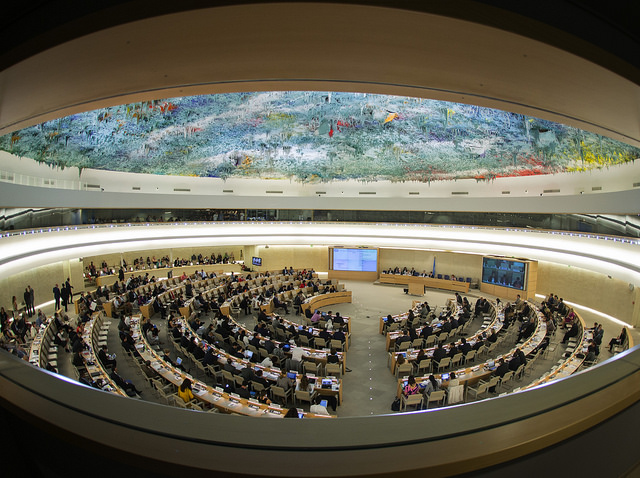
When Foreign Minister Julie Bishop launched Australia’s bid for a seat on the UN Human Rights Council (HRC) in 2015, gender equality and indigenous people’s rights were two of the five ‘pillars’ of the campaign. In an address to the UN General Assembly last week, Bishop reaffirmed Australia’s commitment to furthering international standards of human rights, to make ‘meaningful difference to the lives of individuals’.
Things are looking good for the campaign, so I discuss here how Australia could turn those pillars into policies. Bishop’s laudable aims might flourish or fizzle, depending on how Australia deals with domestic shortcomings in its treatment of indigenous people and asylum seekers, especially as both issues also have incredibly complex gender equality challenges. Australia’s contentious domestic human rights record might diminish potential leadership opportunities in the HRC. The international and domestic agendas for gender equality and indigenous rights should not be siloed off from each other.
A failure to align our international and domestic policies on human rights may undermine our ability to provide what Bishop called ‘principled’ leadership in the council. Of course, some current HRC members have woeful human rights records (Saudi Arabia, Kenya, the Philippines and Nigeria among them), but Australia should not be held to those standards. We should lead by example, standing tall and upholding international standards of equality, good governance and democracy—at home and on the global stage.
Aboriginal and Torres Strait Islander women are often the most disadvantaged within their already deprived communities, facing both gender and racial discrimination. Aboriginal women and girls suffer extraordinary levels of assault; Aboriginal mothers are 17.5 times more likely to die from homicide than non-Aboriginal mothers. Aboriginal women are the fastest growing segment of Australia’s prison population; they’re 21 times more likely to be imprisoned than non-indigenous women.
In 2011, the Department of Social Services released the third national plan to reduce violence against women and their children, which listed Aboriginal and Torres Strait Islander women and children as a priority area. However, the 2014 UN periodic review of Australia identified the ‘unacceptable level of disadvantage experienced by Aboriginal and Torres Strait Islander peoples’, as well as $13.4 million worth of cuts to funding of indigenous legal aid and policy reform programs. The 2015 Human Rights Watch review of Australia further highlighted the controversial elements of Australian policy in addressing indigenous rights. These references, combined with the statistics for assault, homicide and incarceration, show that a far stronger government commitment is needed.
Bishop’s pledge to advance rights for indigenous peoples falls considerably short of the mark. Australia’s position on international indigenous human rights risks being undermined by the unsatisfactory conditions faced by indigenous Australians.
To sit confidently on the HRC and to speak authoritatively on human rights problems elsewhere, Australia should concentrate urgently on improving the security, rights and resource access of Australian indigenous peoples, particularly women. If Australia doesn’t maintain robust and sustainable policies that advocate for citizens who are the most vulnerable, with limited agency or access to resources, its HRC membership won’t stand up to scrutiny.
There’s been no real effort to integrate gender perspectives into Australia’s refugee and humanitarian program; nor does Australia’s national action plan on women, peace and security ‘have a mandate to incorporate the protection of women and their dependents [sic] fleeing conflict zones … as irregular migrants or asylum seekers’.
It’s vital to consider the gendered experiences of refugees and irregular migrants when processing immigration and resettlement streams. Women are often disproportionately affected by conflict, war or trauma, and often need specific types of support and welfare as a result (such as sexual health care, childcare and education). Australia’s commitments to gender equality and to women, peace and security can align to address vital issues for women fleeing conflict. For example, Julie Bishop’s pledge to create a further 12,000 places for the permanent resettlement of refugees fleeing war in Syria and Iraq would benefit from a nuanced policy that addresses gender-specific concerns and experiences. The safety and security of vast numbers of women and children remain precarious while they wait for visa applications to be processed.
Australia’s stand on human rights will seem capricious and opportunistic for as long as it champions international human rights principles without applying those principles to domestic challenges. Canberra has chosen to highlight certain elements of human rights in its five HRC campaign pillars. It should seize the opportunity of being on the HRC to demonstrate meaningful reforms, provide effective leadership and shape future policy.
With opportunity comes responsibility. If Australia wants to position itself as a role model that’s truly committed to advancing indigenous rights and gender equality internationally, prioritising the rights of the most vulnerable Australians should be the first step.

